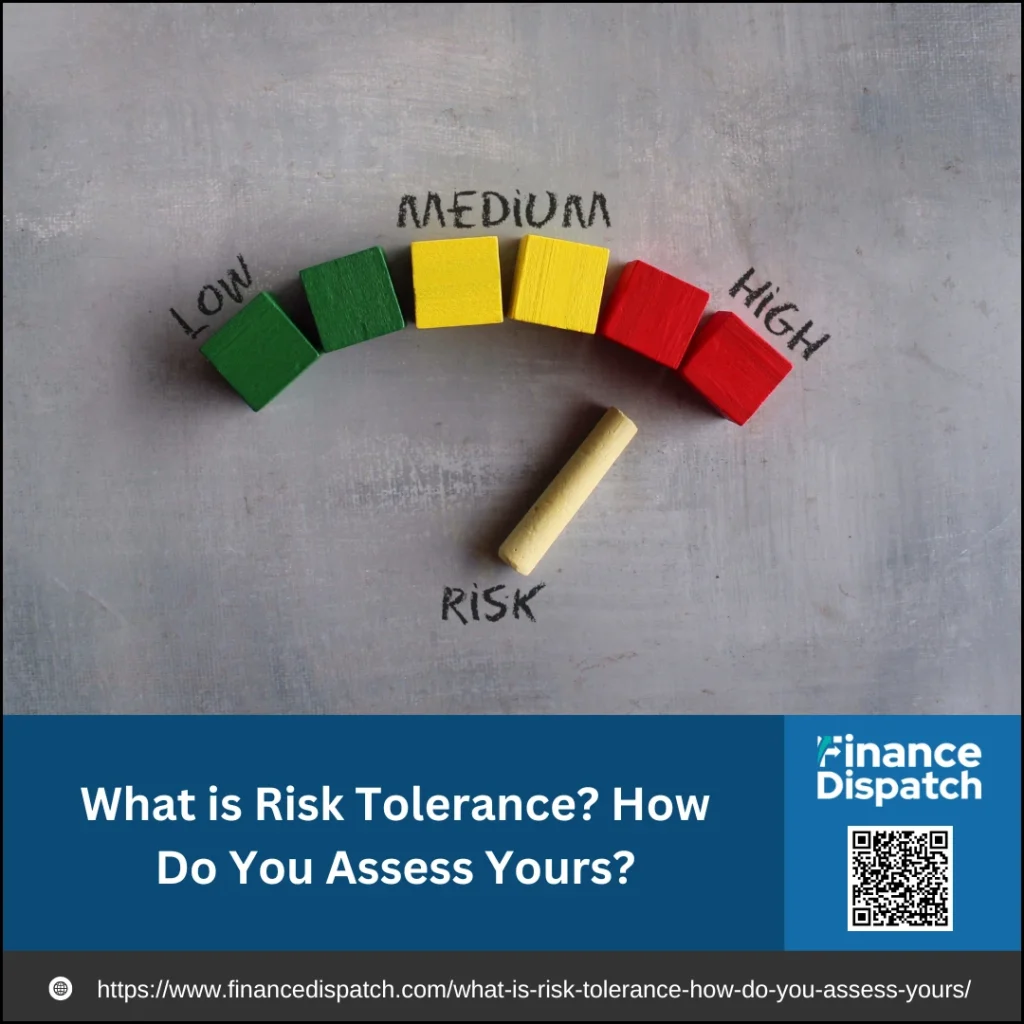When it comes to investing, understanding your risk tolerance is crucial. Risk tolerance refers to your ability and willingness to endure market fluctuations and potential losses while pursuing financial growth. Every investor has a unique comfort level with risk, influenced by factors like financial goals, investment experience, and personal mindset. Assessing your risk tolerance helps you build a portfolio that aligns with your long-term objectives, ensuring that you stay invested without unnecessary stress. In this article, we’ll explore what risk tolerance is, why it matters, how to assess it, and how to match your investment strategy to your comfort level.
What is Risk Tolerance?
Risk tolerance is the degree of variability in investment returns that an individual is willing to withstand. It represents how comfortable you are with the ups and downs of the market and the potential for financial loss. Some investors can tolerate significant fluctuations in their portfolio value, aiming for higher long-term returns, while others prefer stability, even if it means lower potential gains. Your risk tolerance is shaped by factors such as your financial situation, investment goals, time horizon, and emotional response to market volatility. Understanding your risk tolerance is essential for making informed investment decisions that align with both your financial objectives and your peace of mind.
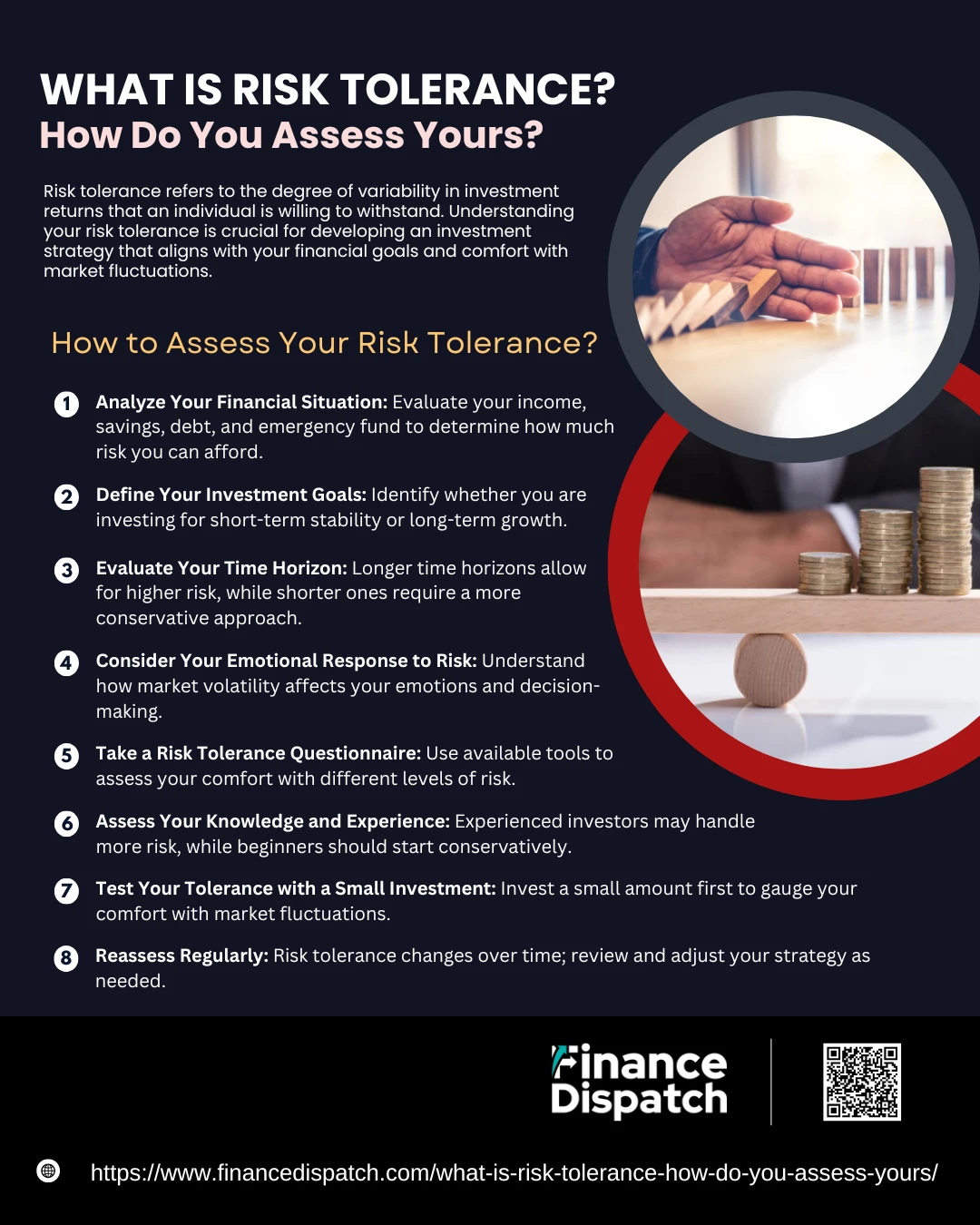 How to Assess Your Risk Tolerance?
How to Assess Your Risk Tolerance?
Risk tolerance is a crucial factor in making investment decisions that suit your financial goals and emotional comfort level. It determines how much risk you can handle while still feeling secure in your investment strategy. Some investors are comfortable with market volatility and potential losses, while others prefer a steady and conservative approach. Assessing your risk tolerance requires evaluating your financial situation, investment objectives, and emotional response to risk. Below are key steps to help you determine your risk tolerance and build a portfolio that aligns with your needs.
1. Analyze Your Financial Situation
Start by assessing your current financial status, including your income, savings, expenses, and outstanding debts. If you have a stable income, an emergency fund, and minimal debt, you may be able to take on more risk. However, if you are financially dependent on your investments for short-term needs, a conservative approach may be better.
2. Define Your Investment Goals
Your financial goals play a significant role in determining your risk tolerance. Are you investing for a long-term goal like retirement, or do you need funds in the next few years for a home purchase or education? Long-term goals allow for more risk-taking since you have time to recover from market downturns, while short-term goals require a more stable investment approach.
3. Evaluate Your Time Horizon
Time horizon refers to how long you plan to keep your investments before needing access to the funds. Investors with a longer time horizon, such as 10–20 years, can afford to take more risks because they have time to recover from market fluctuations. Conversely, if you need your money in a few years, you should opt for lower-risk investments to preserve capital.
4. Consider Your Emotional Response to Risk
Your ability to handle market fluctuations emotionally is just as important as your financial capability. If market downturns cause you anxiety or lead to impulsive decision-making, you may have a lower risk tolerance. On the other hand, if you can stay patient during market volatility and avoid panic selling, you may be suited for higher-risk investments.
5. Take a Risk Tolerance Questionnaire
Many financial institutions offer risk tolerance assessments in the form of questionnaires. These tools ask about your financial situation, investment goals, and emotional reactions to market volatility to provide insights into your risk profile. Taking one can help clarify your investment approach.
6. Assess Your Knowledge and Experience
Your familiarity with investing and financial markets also influences your risk tolerance. Experienced investors who understand market cycles and risk management strategies are often more comfortable with risk. If you’re a beginner, starting with lower-risk investments and gradually increasing exposure as you gain experience is a smart approach.
7. Test Your Tolerance with a Small Investment
If you’re uncertain about your risk tolerance, try investing a small amount in various asset types. Observe how you feel about price fluctuations and market volatility. This hands-on experience will help you better understand your comfort level with risk before committing larger amounts.
8. Reassess Regularly
Risk tolerance is not fixed—it changes based on your financial circumstances, life events, and market conditions. For example, if you receive a promotion or inherit wealth, you may be willing to take on more risk. On the other hand, nearing retirement or experiencing a job loss might make you more conservative. Reassess your risk tolerance periodically and adjust your portfolio accordingly.
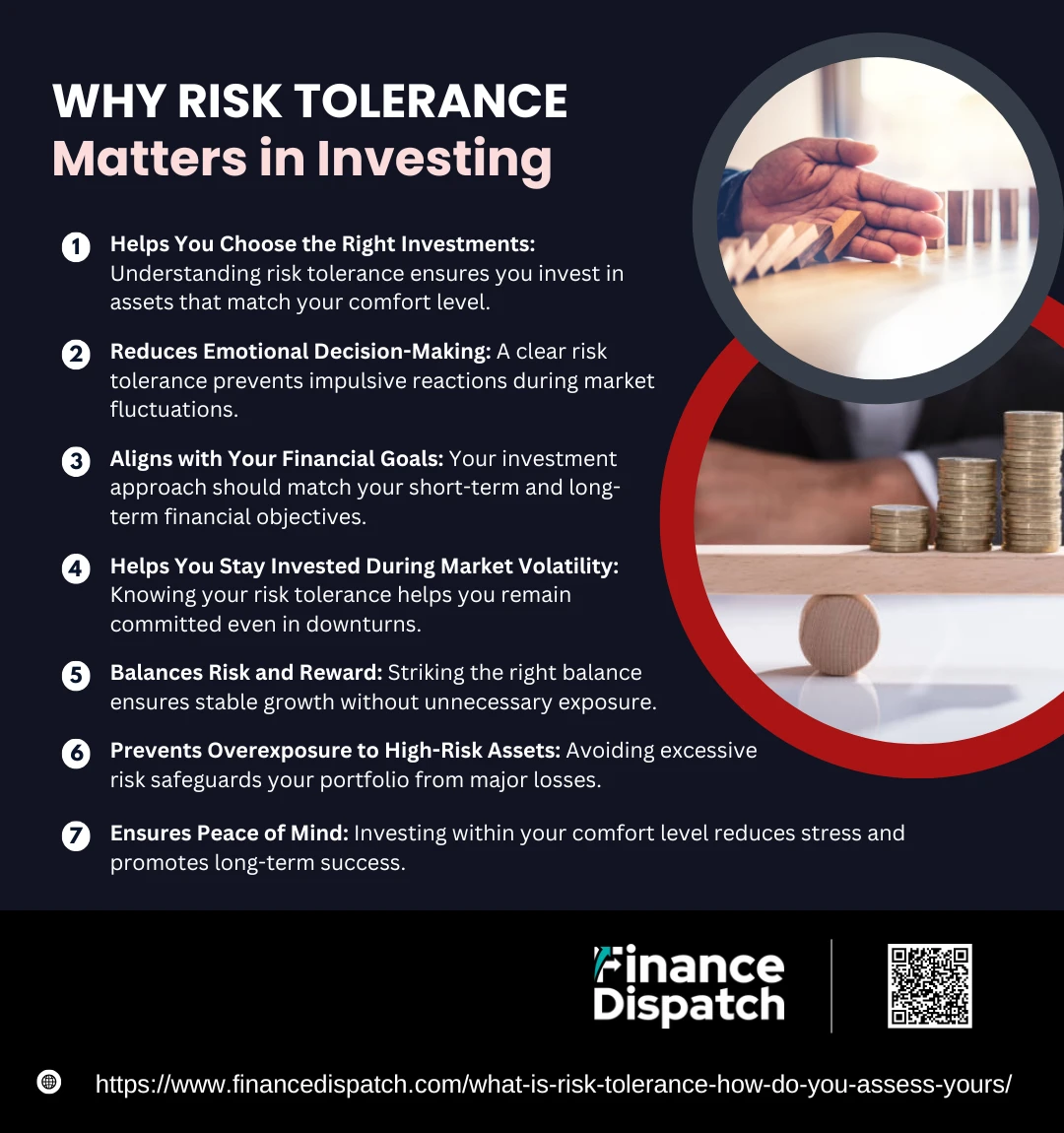 Why Risk Tolerance Matters in Investing
Why Risk Tolerance Matters in Investing
Risk tolerance is a crucial factor in shaping your investment strategy. It determines how much uncertainty and potential loss you can endure while aiming for financial growth. Every investor reacts differently to market fluctuations—some stay calm during downturns, while others panic and make rash decisions. Assessing your risk tolerance helps you build a portfolio that aligns with your financial goals, time horizon, and emotional comfort level. Without understanding your ability to handle risk, you may invest too aggressively and suffer losses beyond your comfort zone or be too conservative and miss out on potential gains. Below are key reasons why risk tolerance plays a vital role in investing.
1. Helps You Choose the Right Investments
Not all investments carry the same level of risk. Stocks, for example, are more volatile than bonds, while mutual funds offer a diversified approach. Understanding your risk tolerance ensures that you choose assets that fit your comfort level and financial needs. An investor with high risk tolerance may lean towards stocks, while someone with low tolerance might prefer fixed-income securities.
2. Reduces Emotional Decision-Making
Emotions can be an investor’s worst enemy. Fear and panic during market downturns often lead to selling investments at a loss, while greed during bull markets can result in taking excessive risks. Investors with a well-defined risk tolerance are less likely to make impulsive decisions, helping them stay committed to their strategy even in volatile markets.
3. Aligns with Your Financial Goals
Your investment approach should reflect your short-term and long-term financial objectives. If you’re saving for retirement 30 years down the line, you may afford to take more risks than someone saving for a home in the next five years. Risk tolerance ensures that your portfolio is structured in a way that supports your goals without unnecessary exposure to volatility.
4. Helps You Stay Invested During Market Volatility
Financial markets go through inevitable cycles of growth and decline. Investors who understand their risk tolerance are more likely to stay invested during market downturns rather than selling in fear. This resilience is crucial because historically, markets have always rebounded, and long-term investors benefit from staying the course.
5. Balances Risk and Reward
There’s always a trade-off between risk and reward. Higher-risk investments often come with greater potential returns, while lower-risk options offer stability but lower gains. Knowing your risk tolerance helps you strike the right balance, ensuring that your investments align with both your financial capacity and emotional well-being.
6. Prevents Overexposure to High-Risk Assets
Without a clear understanding of your risk tolerance, you may take on more risk than you can handle. Overexposure to volatile assets can lead to significant losses, which could be financially and emotionally devastating. A well-calibrated portfolio ensures that your investments are diversified and aligned with your risk appetite.
7. Ensures Peace of Mind
Investing shouldn’t cause constant stress. If you’re frequently anxious about your portfolio’s performance, you may be investing beyond your risk tolerance. Building a portfolio that aligns with your comfort level allows you to invest with confidence and peace of mind, helping you stay on track for long-term success.
Types of Risk Tolerance
Risk tolerance varies from person to person and influences how an investor approaches financial decision-making. It is typically categorized into different levels, ranging from conservative to aggressive, based on an individual’s ability to handle market fluctuations. Some investors prioritize stability and minimal risk, while others are comfortable with high-risk investments in pursuit of greater returns. Understanding the different types of risk tolerance helps investors choose suitable asset allocations and strategies that align with their financial goals and comfort levels.
Types of Risk Tolerance Overview
| Risk Tolerance Type | Description | Typical Investment Approach | Examples of Investments |
| Conservative | Prefers low-risk investments with minimal volatility, prioritizing capital preservation over high returns. | Focuses on stable, income-generating assets with lower exposure to market fluctuations. | Bonds, fixed deposits, money market funds, dividend-paying stocks. |
| Moderate-Conservative | Willing to take a small amount of risk but still prefers stability. Seeks slightly higher returns than conservative investors. | Diversifies between low-risk and moderate-risk assets to balance growth and safety. | A mix of bonds, index funds, blue-chip stocks, balanced mutual funds. |
| Moderate | Accepts moderate levels of risk for potentially higher long-term returns while still managing downside risk. | Invests in a mix of equity and fixed-income assets to balance growth and protection. | A combination of stocks, ETFs, mutual funds, and bonds. |
| Moderate-Aggressive | Comfortable with taking risks for long-term growth but seeks some protection against major downturns. | Allocates a larger portion of the portfolio to equities while keeping some lower-risk assets. | Growth stocks, REITs, sector-specific ETFs, and corporate bonds. |
| Aggressive | Focuses on high-risk, high-reward opportunities, willing to endure significant market fluctuations. | Prioritizes capital appreciation over stability, with most investments in equities and volatile markets. | Growth stocks, IPOs, cryptocurrencies, venture capital, emerging market funds. |
How Risk Tolerance Affects Portfolio Allocation
Risk tolerance plays a key role in determining how an investor structures their portfolio. It influences the balance between different asset classes, such as stocks, bonds, and cash, to match an investor’s comfort level with risk. A higher risk tolerance allows for a greater allocation to equities, which have the potential for higher returns but also higher volatility. Conversely, a lower risk tolerance leads to a more conservative portfolio with a focus on capital preservation and steady income. Below is an overview of how risk tolerance impacts portfolio allocation.
Portfolio Allocation Based on Risk Tolerance
| Risk Tolerance Type | Stock Allocation | Bond Allocation | Cash/Other Assets | Investment Objective |
| Conservative | 20%-40% | 50%-70% | 10%-20% | Preserve capital and generate steady income. |
| Moderate-Conservative | 40%-55% | 40%-50% | 5%-10% | Balance of stability and moderate growth. |
| Moderate | 55%-70% | 25%-40% | 5%-10% | Moderate risk for long-term capital appreciation. |
| Moderate-Aggressive | 70%-85% | 10%-25% | 5%-10% | Higher growth potential with some risk management. |
| Aggressive | 85%-100% | 0%-15% | 0%-5% | Maximum growth, willing to accept high volatility. |
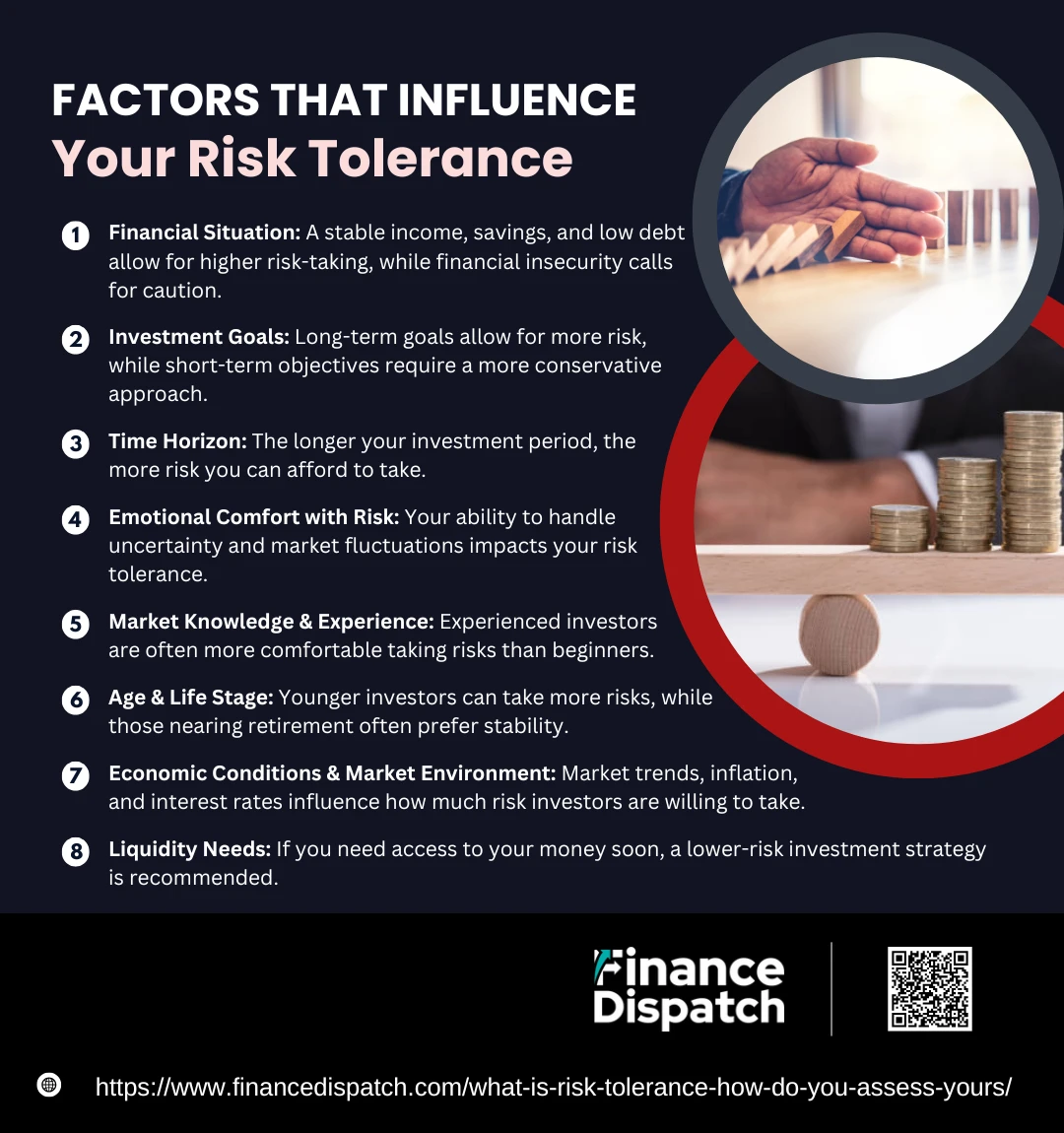
Factors That Influence Your Risk Tolerance
Risk tolerance is not a one-size-fits-all concept—it varies based on individual circumstances and can evolve over time. While some investors are comfortable with high levels of risk, others prefer a more conservative approach. Your ability to take risks is influenced by both financial and psychological factors, as well as external conditions like market fluctuations and economic trends. Understanding what shapes your risk tolerance is essential for building a portfolio that aligns with your financial goals and emotional comfort level. Below are key factors that determine how much risk you can handle in your investments.
Key Factors That Influence Risk Tolerance:
- Financial Situation: Your current financial health plays a significant role in your risk tolerance. If you have a stable income, a strong emergency fund, and little to no debt, you can afford to take on more risk. However, if you have unstable finances, high debt, or depend on your investments for daily expenses, a conservative approach is more suitable.
- Investment Goals: Your reason for investing impacts how much risk you should take. If you’re saving for retirement 30 years down the road, you can afford to invest in higher-risk assets like stocks, as you have time to recover from market downturns. On the other hand, if you’re investing for a short-term goal, such as buying a home in five years, lower-risk assets like bonds or cash equivalents are more appropriate.
- Time Horizon: The length of time you plan to invest significantly influences your risk tolerance. If you have a long investment horizon, you can take on more risk because markets tend to recover over time. Shorter investment horizons require a more conservative approach to protect your capital.
- Emotional Comfort with Risk: Risk tolerance is not just about financial ability—it’s also about how comfortable you are with uncertainty. If market downturns cause you stress and anxiety, you may prefer a conservative portfolio with lower volatility. If you can remain calm during market fluctuations, you may be more suited for an aggressive investment strategy.
- Market Knowledge & Experience: Investors with experience and a strong understanding of financial markets are often more comfortable taking risks. They know that short-term volatility is normal and that long-term investments can recover. Less experienced investors, however, may be more cautious due to a lack of familiarity with market trends.
- Age & Life Stage: Risk tolerance often changes with age. Younger investors typically have a higher risk tolerance because they have more time to recover from market losses. As you approach retirement, preserving capital becomes more important, leading to a lower risk tolerance and a shift toward safer investments.
- Economic Conditions & Market Environment: External factors like inflation, interest rates, and market downturns can affect how much risk investors are willing to take. In strong economic periods, people may be more willing to invest in riskier assets, while during recessions, investors tend to become more conservative.
- Liquidity Needs: If you anticipate needing your invested money in the near future, your risk tolerance should be lower. Investments in volatile assets, such as stocks, can experience significant price fluctuations, which may result in losses if you need to withdraw funds at the wrong time. Keeping part of your portfolio in liquid, low-risk assets ensures you have access to cash when needed.
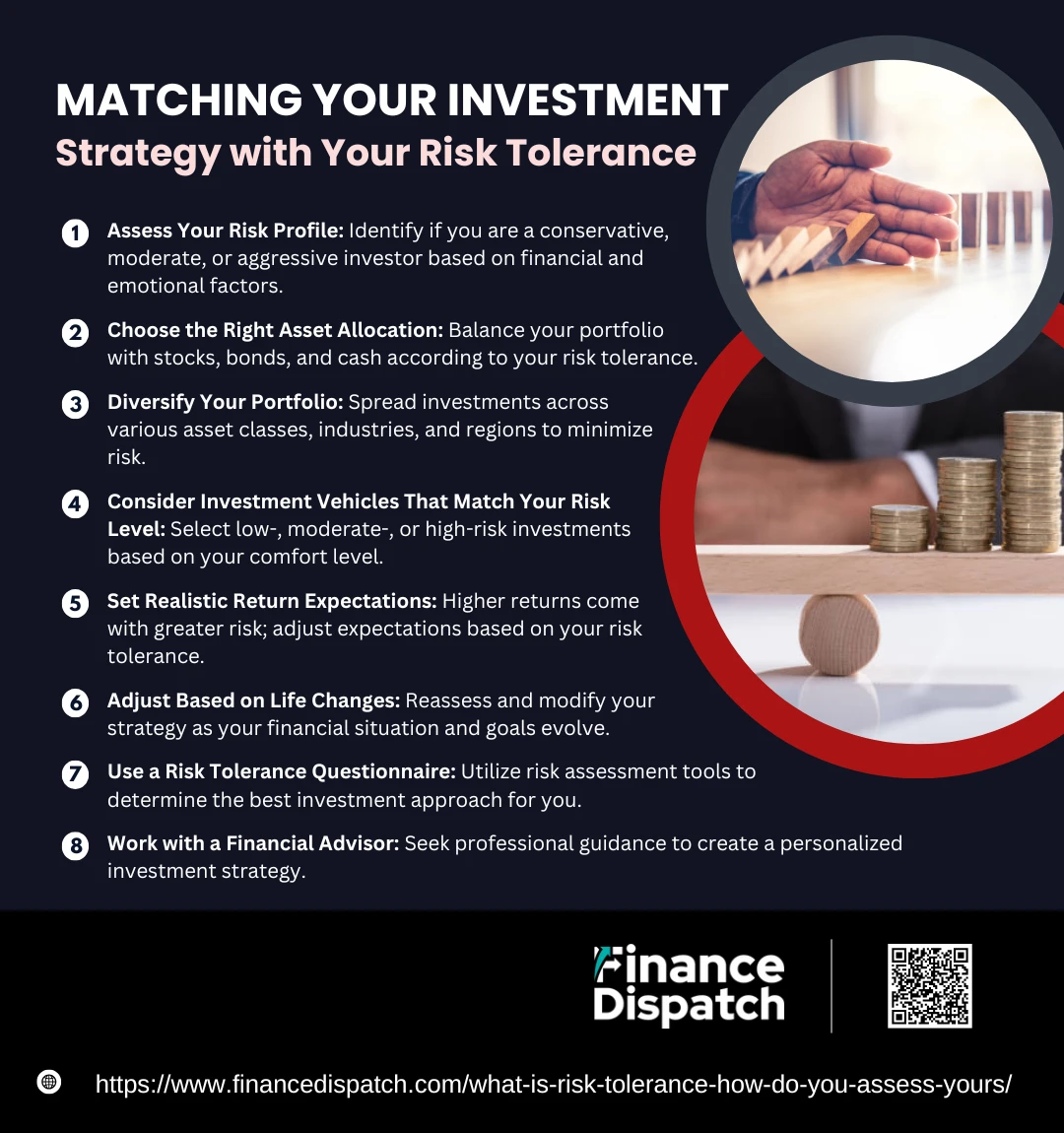 Matching Your Investment Strategy with Your Risk Tolerance
Matching Your Investment Strategy with Your Risk Tolerance
Creating a successful investment strategy requires aligning your portfolio with your risk tolerance. If your investments are too aggressive for your comfort level, you may panic during market downturns and make impulsive decisions. Conversely, if your portfolio is too conservative, you might miss out on potential growth opportunities. By understanding your risk tolerance and selecting the right investment approach, you can build a portfolio that balances risk and reward while keeping you on track toward your financial goals. Below are ways to match your investment strategy with your risk tolerance.
How to Align Your Investment Strategy with Your Risk Tolerance:
1. Assess Your Risk Profile: Start by determining whether you are a conservative, moderate, or aggressive investor based on your financial stability, investment goals, and emotional reaction to risk. This self-assessment will serve as the foundation for building your portfolio.
2. Choose the Right Asset Allocation: The proportion of stocks, bonds, and cash in your portfolio should reflect your risk tolerance.
- Conservative investors may hold more bonds and fixed-income assets for stability.
- Moderate investors may balance stocks and bonds for steady growth.
- Aggressive investors may allocate most of their portfolio to stocks and alternative investments for higher returns.
3. Diversify Your Portfolio: Avoid putting all your money in a single investment. Instead, spread your assets across different asset classes, industries, and geographic regions to reduce risk and increase potential growth over time.
4. Consider Investment Vehicles That Match Your Risk Level: Different types of investments carry different risk levels:
- Low-risk investments: Bonds, dividend stocks, index funds, treasury securities.
- Moderate-risk investments: Balanced mutual funds, blue-chip stocks, real estate investment trusts (REITs).
- High-risk investments: Growth stocks, emerging markets, cryptocurrencies, venture capital.
5. Set Realistic Return Expectations: The higher the potential return, the greater the risk. If you prioritize safety, expect more modest returns. If you’re aiming for high growth, be prepared for significant market fluctuations.
6. Adjust Based on Life Changes: Your risk tolerance is not static; it changes based on life events such as marriage, job changes, or retirement. Reassess your investment strategy periodically to ensure it aligns with your evolving financial goals.
7. Use a Risk Tolerance Questionnaire: Many financial institutions offer risk assessment tools that help you determine the right investment strategy based on your responses. These tools provide a personalized approach to investing.
8. Work with a Financial Advisor: If you’re unsure about your risk tolerance or need guidance in structuring your investment portfolio, consult a financial expert. A professional can help tailor an investment plan that suits your individual risk preferences and financial situation.
Common Mistakes in Evaluating Risk Tolerance
Assessing risk tolerance correctly is crucial for making sound investment decisions. Many investors either overestimate their ability to handle risk or underestimate their capacity for long-term growth. These miscalculations can lead to poor investment choices, unnecessary stress, or missed opportunities. Below are common mistakes people make when evaluating their risk tolerance.
Common Mistakes in Evaluating Risk Tolerance:
- Confusing Risk Tolerance with Risk Capacity: Just because you can afford to take risks doesn’t mean you’re emotionally comfortable with them.
- Ignoring Emotional Reactions to Market Volatility – Overconfidence in handling losses can lead to panic selling during downturns.
- Basing Risk Tolerance on Market Trends: Feeling risk-tolerant in a bull market but risk-averse in a downturn leads to inconsistent investing.
- Underestimating the Impact of Time Horizon: A long investment horizon allows for more risk-taking, but many fail to factor this in.
- Not Revisiting Risk Tolerance Over Time: Life changes affect risk tolerance; failing to reassess can lead to misaligned investment strategies.
- Overdiversifying or Underdiversifying: Spreading investments too thin or focusing too much on one asset class can limit returns or increase risk.
- Letting Fear or Greed Drive Decisions: Emotional investing often leads to impulsive choices that don’t reflect true risk tolerance.
- Relying Solely on Risk Tolerance Questionnaires: Online tools help, but personal reflection and expert advice are equally important.
Can Your Risk Tolerance Change Over Time?
Yes, your risk tolerance can change over time due to various factors, including financial circumstances, life events, and market conditions. As you progress through different stages of life, your ability and willingness to take risks may shift. For example, a young investor with a stable income and a long time horizon may feel comfortable taking on higher risks, while someone nearing retirement may prioritize capital preservation and lower-risk investments. Major life changes such as marriage, having children, career advancements, or unexpected financial setbacks can also impact how much risk you’re willing to take. Additionally, personal experiences with market fluctuations can alter your emotional response to risk—some investors become more risk-averse after a market downturn, while others develop more confidence. Regularly reassessing your risk tolerance ensures that your investment strategy remains aligned with your evolving financial goals and comfort level.
Conclusion
Understanding your risk tolerance is essential for making informed investment decisions that align with your financial goals and emotional comfort level. Whether you are a conservative, moderate, or aggressive investor, assessing your ability to handle market fluctuations helps you create a balanced portfolio that suits your needs. Since risk tolerance can change over time due to life events, financial shifts, and market conditions, it’s important to reassess it regularly to ensure your investment strategy remains aligned with your current situation. By avoiding common mistakes, diversifying wisely, and staying committed to your long-term objectives, you can build a portfolio that supports financial growth while maintaining peace of mind.



